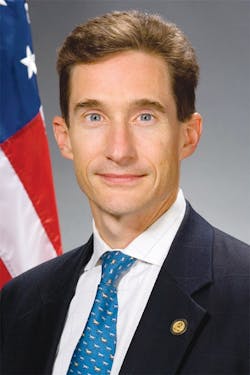Well-Fed Up
The swirling controversy over eutrophication and nutrients is prompting a stormy debate over federal and state power-sharing, but the solution to the pollution and political confrontation lies in better science and collaboration rather than extreme shifts in fed-state relations.
Many accuse the U.S. Environmental Protection Agency (EPA) of seizing too much ground in the state-based nutrient standards arena and dictating local diets through overly stringent total maximum daily load (TMDL) requirements under the federal Clean Water Act (CWA). They fear the Feds have gone too far in pushing state development of scientifically and legally defensible numeric criteria for nutrients, side-stepping state authorities and setting up producers, developers and others for failure and fines.
There’s truth and fiction to the story, but also a lot of misunderstanding and hyperbole in the quest for “proper balance” between federal and state—a concept that seems to ebb and flow over time depending on environmental, economic and political realities.
A Case for Intervention
In January 2009, as EPA’s assistant administrator for water, I made the determination under the CWA that Florida’s efforts on phosphorus and nitrogen were insufficient and that EPA needed to step in and begin the process of developing numeric criteria. We recognized that the state was taking action and making some progress with narrative standards, but the large number of impaired water bodies (e.g., 1,000 miles of rivers and streams and 350,000 acres of lakes) justified an escalated effort. The Obama administration followed through and issued final standards for Florida’s lakes and inland waters in November 2010. The controversial regulation includes some tools for site-specific alternative criteria and extended effective dates. EPA intends to issue similar regulations for Florida’s estuarine and coastal waters by 2012.
The key, of course, is how to move forward cooperatively and find the way as soon as possible to turn the keys back over to a highly sophisticated state agency fully capable of charting its own course. The National Academy of Sciences can help as well. One of its committees recently held a workshop in Florida on the rule’s economic assumptions to shed light on the wide range of rosy and gloomy cost estimates.
Setting the Stage
Nationally, EPA and state water pollution control administrators continue to work on nutrient pollution strategies. Agriculture also is weighing in to find solutions. The U.S. Department of Agriculture has launched a four-year, $320-million Mississippi River Healthy Watersheds Initiative that relies on technical and financial assistance, perhaps setting the stage for similar efforts in a future Farm Bill, although fiscal constraints on conservation spending loom large.
Some states are concerned about EPA’s TMDL pollution diets for permitted and diffuse sources, particularly in areas such as the Chesapeake Bay (where the agency issued an historic multi-state TMDL in December 2010) and the Mississippi River/Gulf of Mexico watershed (where the agency has been turning its attention for years but has yet to follow the Chesapeake Bay model). The concern is understandable. It’s also hard work, expensive and politically difficult for states to make progress in controlling nitrogen and phosphorus pollution—a leading cause of water quality impairment—without some assistance from EPA.
The National Academy of Sciences has waded into dead zones and algae blooms on several occasions as well. For example, a 2010 report on the Mississippi River Basin and northern Gulf of Mexico recommended “establishing a numeric limit for the amount of nutrients in the water ... to act as an endpoint for EPA and the Mississippi River states to set water quality standards for nutrients throughout the basin.” I tend to agree: To make progress, we need solid, enforceable, defensible, achievable criteria, preferably set by states, to drive results and also create markets for trading and water quality upgrading.
Restructuring the Relationship
Congress recently has stepped in with tough oversight hearings and aggressive legislation to “reign in regulators” from EPA. In July, the House of Representatives passed H.R. 2018, the Clean Water Cooperative Federalism Act of 2011, a controversial and significant shift in the balance of power between EPA and states under the CWA. The bill essentially would prevent EPA from taking over a state-approved standards-setting effort, such as in Florida’s case with nutrients. In my view, the current version goes too far, too fast and with too many questionable impacts on downstream states, communities and ecosystems. However, I also believe it raises some legitimate issues that, if channeled properly, could allow for better partnerships to spring forth.
Perhaps one of the best results of the debate would be to keep EPA’s override authority on the table, allowing the federal agency to step in and promulgate standards in lieu of a state’s—but only when necessary to further a strong federal interest and consistent with a state-friendly protocol. Of course, none of that is new; it’s more a question of how to define the conditions and build the trust along the way without violating the letter or spirit of the CWA.
Sometimes it’s better to keep and refine collaboration tools, including regulatory hammers, than to throw them away. There’s also a need for an interstate umpire to step in from time to time to protect downstream interests and regional ecosystems. And, as the National Academy of Sciences and virtually every water professional has pointed out, we need more time and money invested in the science of understanding, controlling, treating and recovering nutrients. Cost-effective technologies and smart strategies will help with over-fed lakes and fed-up states.
Download: Here
